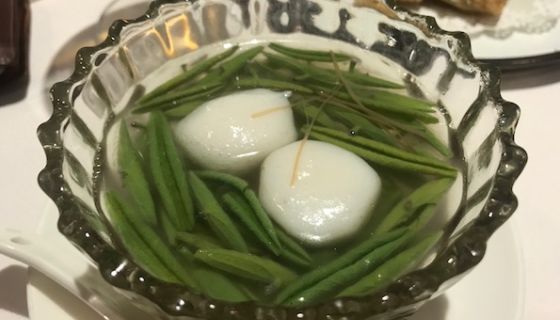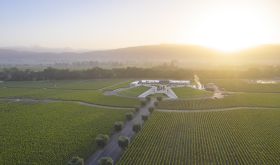As he tucked in to Hangzhou-style stewed duck and duck tongue at this excellent lunch in Shanghai, my companion, who was born and bred there, explained, ‘In this city we cook our ingredients rather simply but we then spend a lot of time around the table discussing and enjoying them. It’s the opposite in Beijing, where, incidentally, my wife is from.’
We were installed in the unusually named Le Patio & La Famille, which has been in business for just over six years – a long time by the standards of this fast-moving city. Immediately after lunch I was to be interviewed by a reporter from a Chinese lifestyle magazine about what it takes to do my job.
My response was a good appetite, an innate curiosity, an ability to write enthusiastically, and, perhaps most importantly, a collection of friends in cities around the world who can point me in the direction of interesting restaurants. Michelle Garnaut is to be thanked for this particular recommendation. Australian by birth, she first moved to Shanghai to open M on The Bund 25 years ago when she was one of the few Western restaurateurs to recognise the potential of the burgeoning city. Le Patio & Familie, just round the corner from her own, came with her personal approval.
It was then that I ran into the different rules of actually eating out in this city. I tried to book for 8.30 pm but was told that 7 pm was the latest reservation they would accept. I then switched to lunch and asked for a 1.30 pm reservation. No, came the response, 12 o’clock is the latest. I accepted, thinking that we would walk into an empty restaurant. In the event, ours was the last but one table to be occupied.
Le Patio & La Famille occupies the ground floor of what was once an office. The front half, where we sat, is old-fashioned to put it bluntly. White tablecloths to the floor with high-backed, padded chairs and table lamps make for a comfortable setting. Brick, being the dominating feature of the rear section, makes it far noisier.
The restaurant has two other distinguishing features. The first is their staff uniforms. Waitresses wear green tunics and black skirts as well as numbers on their badges rather than names. Our waitress was Number 11. The men wear black and it was Manager No 1 who took our order.
Then there are the outfits of those whose job it is to carry the food to the tables from the kitchen next to the entrance. They are also black, but more relaxed than the managers, and because they are all young – theirs is after all the most physically demanding job – they wear black caps often at jaunty angles.
But the main thing is the food served in this restaurant, which, despite its name, actually specialises in the cooking of the Hanghzou region. As the Chinese saying goes, ‘there is heaven on high while there is Suzhou and Hangzhou on earth’. For centuries Hanghzou has been regarded as heavenly by the Chinese for the city’s abundant wealth, picturesque West Lake and, above all, for its fine delicacies.
From the menu’s opening page we chose two contrasting dishes that were promisingly tagged with a chef’s hat, as a particular recommendation. One was the dish described as roasted cuttlefish, although no roasting is involved, the other the traditional Hangzhou duck dish. Both showed off two particular aspects of this kitchen’s skills and one of Shanghai’s in general.

The first was the brigade’s dexterity with their knives. The cuttlefish, cooked in soy sauce, had been chopped into wafer-thin slices before being put back together on the plate, a technique evident in the preparation of the duck, too. There was in both these dishes, and the rest of what we ate, the artful balance between soy sauce and sugar that is clearly a distinguishing feature of chef Kevin Yang’s work.

We followed with an elegant dish of deep-fried river shrimps, again accentuated by just the appropriate dose of vinegar, and a more robust dish of crab fried with glutinous rice cakes (a dish distinguished on the menu by a ‘thumbs up’). This could have kept us both at the table all afternoon as we relished chewing on the small pieces of crab and picking on the almost irresistible rice cakes.
We ended with two more of the chef’s recommendations: bean curd rolls with yellow fish and a bowl each of West Lake watershield soup, both distinguished in their own fashion. The former were crisp and golden and came with a clever cider dipping sauce while the soothing soup was highlighted by the addition of leaves of watershield (Brasenia schreberi) and fish balls shown top right.
The bill for all this came to 940 RMB (£107.50) including 100 RMB (£11.50) corkage for the delicious bottle of Emilio Lustau old oloroso sherry that my wine-loving friend had brought, a style of wine we both enjoy but here it made a special addition to a meal of such contrasting flavours and textures. ‘Quite simply’, my friend explained, ‘it removes the hassle of switching from white to red and back again that is so often the challenge with a Chinese meal.’
My advice to anyone visiting Shanghai is to book at Le Patio & La Famille. But go early!
Le Patio & La Famille 216 Middle Sichuan Rd, Huangpu District, Shanghai; tel +86 21 6323 1797















